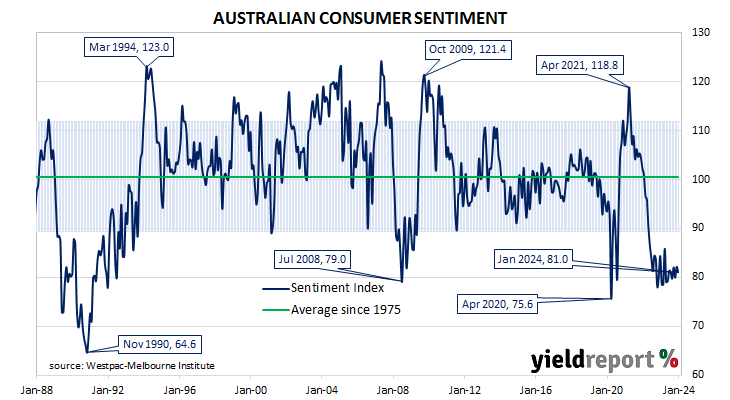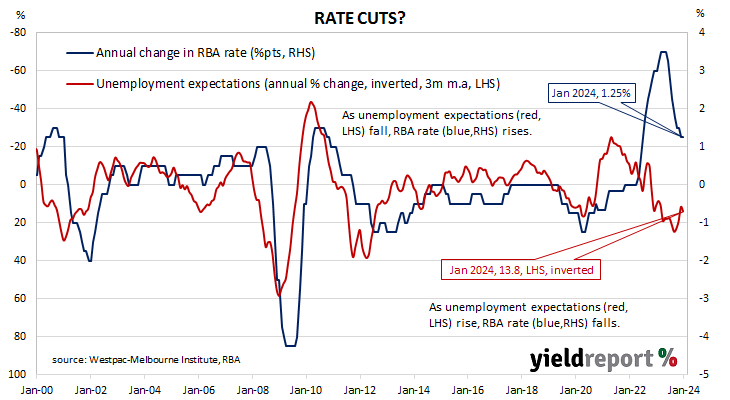Summary: Westpac-Melbourne Institute consumer sentiment index down in January; More pessimistic starts to year only previously seen during early 1990s recession; ACGB yields increase; rate-cut expectations soften; consumers much more ‘hawkish’ on interest rate outlook than financial markets, economists; three of five sub-indices lower; more respondents expecting higher jobless rate.
After a lengthy divergence between measures of consumer sentiment and business confidence in Australia which began in 2014, confidence readings of the two sectors converged again in mid-July 2018. Both measures then deteriorated gradually in trend terms, with consumer confidence leading the way. Household sentiment fell off a cliff in April 2020 but, after a few months of to-ing and fro-ing, it then staged a full recovery. However, consumer sentiment has deteriorated significantly over the past two years, while business sentiment has been more robust.
According to the latest Westpac-Melbourne Institute survey conducted in the second week of January, household sentiment remains stuck at quite pessimistic levels. Their Consumer Sentiment Index declined from December’s reading of 82.1 to 81.0, a reading which is well below the “normal” range and significantly lower than the long-term average reading of just over 101.
“The latest January read is in the bottom 7% of all observations since the survey was first run in the mid-1970s,” said Westpac senior economist Matthew Hassan. “More pessimistic starts to the year have only been seen during the deep recession of the early 1990s.”
Any reading of the Consumer Sentiment Index below 100 indicates the number of consumers who are pessimistic is greater than the number of consumers who are optimistic.
Commonwealth Government bond yields increased on the day. By the close of business, the 3-year ACGB yield had added 7bps to 3.70%, the 10-year yield had gained 8bps to 4.17% while the 20-year yield finished 5bps higher at 4.48%.
In the cash futures market, expectations regarding rate cuts later this year softened. At the end of the day, contracts implied the cash rate would remain close to the current rate of 4.32% and average 4.32% through February, 4.31% in March and 4.295% in April. August contracts implied a 4.10% average cash rate while November contracts implied 3.915%, 40bps less than the current rate.
“Despite easing rate rise fears, consumers are much more ‘hawkish’ on the interest rate outlook in Australia than both financial markets and economists,” added Hassan. “While just over half of consumers expect mortgage rates to rise, futures markets are currently pricing in 50bps in cuts by year-end, with three out of four economists also expecting the cash rate to move lower.”
Three of the five sub-indices registered lower readings, with the “Family finances versus a year ago” sub-index posting the largest monthly percentage loss.
The Unemployment Expectations index, formerly a useful guide to RBA rate changes, rose from 128.9 to 130.7. Higher readings result from more respondents expecting a higher unemployment rate in the year ahead.



